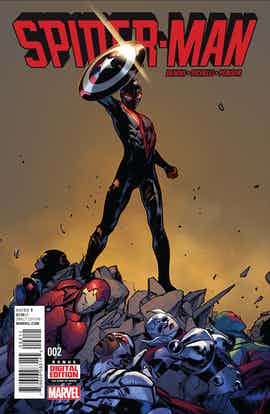
Now that issue two of “Spider-Man” has hit stands, Brian Michael Bendis and Sara Pichelli’s direction for Miles Morales and his new place in the Main Marvel Universe is a little clearer. The tone is lighter than the Ultimate Universe series the pair built together, but it doesn’t skimp out on the quality character drama Bendis does so well. There’s a little bit of dejà vu in the first half of the book, but the back portion — particularly Miles and Ganke’s scene — lifts the issue to the level of quality the creative team is known for.
Bendis makes several new revelations about the characters’ relationships here. Peter sounds harsh during his time with Miles, but understandably so: he’s taking a big brother role with the new kid. Giving Miles the mantle of Spider-Man also means giving him the responsibility, and we all know how Parkers feel about responsibility. Pichelli draws some influence from the Disney XD show in the flashback to when Peter gave Miles his blessing. Seeing the memory through the eyes of a teenager is fun and smart storytelling. Her art is just as awesome in her character work, and it’s a fun distraction before we get the same fight we did last issue. Although the first half of the issue feels like the end of the first issue, Bendis’ character drama is so enjoyable that it doesn’t much matter. Great dialogue can be read out loud and sound natural, and all of his work does that. Does it take up pages? Yes. Do his stories move more slowly? Yes. I don’t mind, though, when the result is as enjoyable as this. Plus, that just means more pages of Pichelli and Ponsor’s art — and who can complain about that?
Bendis Says “Spider-Man” Will Explore Race and Media Issues
One of the best scenes involves Ganke and Miles debating the merits of the world discovering that the new Spider-Man in New York is a person of color thanks to a tear in his mask. It’s a meta moment, and the back-and-forth between the friends is great and highlights both sides of the argument. The conflicting emotions Pichelli gives Miles underscores his struggle with the information; check out the furrowed brow, the squinting eyes, all of it. A lot of story is conveyed through a simple scene where a teenager holds a tablet.
When Miles says doesn’t like the “black” qualifier, it’s a great moment of growth. He wants to be Spider-Man — not black Spider-Man, not Hispanic Spider-Man. He’s right, though; no one would say Jewish Spider-Man or Pacific Northwest Spider-Man, though both could describe white Spider-Man. Miles is a teenager following a legacy while trying to be his own man. That’s a lot of work for an adult, let alone a teen at a charter school. I hope this subplot plays out through the coming issues.
We get a tease of Miles’ first big antagonist in a single page sequence that is well framed and makes the character look like a total boss. I may not like how they got the character to where she is, but they’ve done a lot of work to make her a credible threat since then.
This book is gorgeous fun. While I enjoyed the darker elements of the previous volumes of Miles Morales’ journey, I like the series’ new tone. The cartoony flashbacks, the emphasis on family hijinks, the dialogue, the layouts and fashion choices all build a book that I look forward to reading every month.

